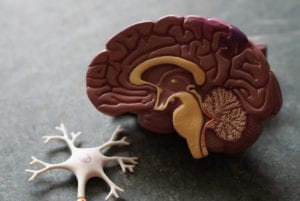What is NeuroKinetic Therapy (NKT)?
Neurokinetic Therapy & Pain Relief
Neurokinetic therapy is offered in the realm of registered massage therapy and provided to patients by RMT’s with extra certification in this area. NKT is a specialized testing and treatment technique that looks to get to the root cause of compensatory patterns that a person is stuck looping on.
The human body (specifically, the peripheral nervous system) is constantly taking in information via receptors found all over (and inside) the body. That environmental (an internal) stimuli then signals to the spinal cord and gets relayed up to the brain (both of which make up our central nervous system). Our brain then decides what to do with that information and sends a signal back down to our body creating a response.

The one part of the brain NKT focuses on is called the motor control centre. As a person learns, grows and develops, the motor control centre takes in information and creates patterned responses. These patterned responses can also be looked at as “habits”. The brain is designed to want to do as little work as possible and expend as little energy as possible. So once a person has created one of these movement patterns or “habits,” the brain will continue using one of these “habits” until or unless it is forced to learn a new path.
Small things in your everyday life can force your brain to create a new habit like having to rotate your head to the left to look at your second computer monitor for the umpteenth time in a day for 5 days a week. Consider another example, if you are in a motor vehicle accident and you sustain a whiplash injury to your spinal column. Your body tenses up and creates a protection mode and learns this new “guarded” pattern to be the new normal. As a result, any person will start developing signs and symptoms as a result of the body communicating to the brain – to remain in this new, forced and faulty habit. Some of the signs to look for in terms of faulty and guarded habits include:
- tension that continues to come back,
- lack of motion in a joint,

- not being able to breathe deeply and efficiently,
- chronic, reoccurring pain,
- headaches,
- joints making noise or grinding, and
- incontinence (peeing) while sneezing.
Using specialized neurokinetic testing and therapy, it’s possible to ask the brain what the compensatory patterns are. Once determined, a trained therapist can release exactly what needs to be released and activate exactly what has been underworking. In essence, we are reawakening the original patterns. Because these patterns are habits, the brain will need to re-see the pattern (via in-office treatments, as well as home care) until it has been able to fully engrain it within the system.
When our patients commit to re-creating original patterns, we start to see the signs of dysfunction slip away. The length of time a faulty pattern has been present will play a role in how long therapy is needed. And when a patient has gone through a large trauma, or even a few small subsequent traumas, there may be many layers that need to be unravelled to restore balance.
If you have struggled with chronic pain from an injury and have seemingly tried everything, consider Neurokinetic Therapy. It can make all the difference, contact us today.
– Courtesy of Nissa Cochran, RMT

